|
Green Bay and New England have outscored opponents by more than 100 points. Touchdown passes are lighting up the night sky. Seven NFL quarterbacks already have at least 20 touchdown passes -- 20 years ago, only eight reached this mark on the entire season. Scoreboards are spinning as never before. Is the reason better athletes on offense -- or is the reason more penalties? It's well known that defensive holding flags have increased this season -- blame the Seattle secondary for that. But there's a 10-year trend toward more flags against the defensive secondary. These trends translate into more first downs and fewer punts. Result? More scoring drives. Considering only accepted penalties, so far there have been 137 defensive pass interference walk-offs this season, compared to 110 at the same point in the season a decade ago. That's a 25 percent increase. There have also been 137 accepted defensive holding penalties, compared to 99 at this juncture a decade ago. That's a 38 percent increase. Defensive pass interference means a chunk of yardage, and both fouls provide an automatic first down. A decade ago at this point in the season, there had been 568 first downs by penalty. This season it's 652, a 15 percent increase. More first downs means fewer punts. A decade ago, 1,581 punts had been launched at this juncture. This season it's down to 1,468. More automatic first downs, fewer punts. Skadoosh -- spinning scoreboards. New rules against deliberate helmet-to-helmet contact also help the offense. Sunday at New Orleans, Cincinnati facing third-and-long, A.J. Green ran a stutter-go and beat the cornerback. Saints' safety Rafael Bush was closing but pulled up one step before he would have drilled Green, who made a 38-yard reception that proved the game's decisive down. Five years ago, Bush legally could have laid Green out, which might have broken up the catch. This year, Bush knew that contact with Green's helmet would be an automatic first down whether the catch was made or not. So he pulled up and hoped the pass would be dropped. That's exactly what reformers want defenders to do in potential helmet-to-helmet situations -- and if reducing helmet-to-helmet contact favors the offense, so be it. Vicious hits on defenseless players are "substantially down," which is good news. But much of the increase in flags against the secondary comes from what seems like a trend toward ticky-tacky calls, as if there is now an assumption of guilt against pass defenders. These corrections suggest themselves: Just as defensive holding was an officials' "point of emphasis" this season, ignoring incidental contact should be next season. At Rule 8, Section 4, Article 4 says: "Beyond the five-yard zone, incidental contact may exist between receiver and defender as long as it does not materially affect or significantly impede the receiver, creating a distinct advantage. Additionally, Rule 8, Section 5, 3 (a) says: If there is any question whether contact is incidental, the ruling shall be no interference." The zebras need a refresher course in this standard.  Rather than automatic first down, defensive holding should be 10 yards and replay the down, just like offensive holding. Under current rules, the defense is penalized more than the offense for the same foul. Let's make defensive and offensive holding equivalent. Stricter enforcement of the pick play by the offense. This season on two-man combo patterns, many wide receivers and tight ends look like Fuzzy Thurston pulling on a Green Bay Packers 1960s power sweep. No secondary can cover a receiver who for intents and purposes has a downfield blocker before the pass is released. Here's the rule that needs to become a point of emphasis, also at 8, 5: "Blocking more than one yard beyond the line of scrimmage by an offensive player prior to a pass being thrown is offensive pass interference. Note: It is also pass interference by the offense to block a defender beyond the line while the pass is in the air, if the block occurs in the vicinity of the player to whom the pass is thrown." And a fabulous suggestion from reader Zac Maodus of Fort Lauderdale, Florida: "If defensive pass interference results in automatic first down, shouldn't offensive pass interference result in an automatic fourth down?" That rule change would discourage pick plays and pushing off by offensive receivers, swinging the pendulum toward officiating parity between offense and defense. In other football news, if the season ended today, 4-6 Atlanta would host a playoff game, while defending champion Seattle, at 6-4, would be out; the previous defending champion, Baltimore, also 6-4, also would be out. Six teams at 6-4 would be denied the postseason, while 4-6 Atlanta got to host a party. The NFL's goofy playoff formula is marching toward its worst outcome since 2008, when 8-8 San Diego hosted a postseason party, but 11-5 New England wasn't invited to the playoffs. Unless you think its worst outcome was 2010, when 7-9 Seattle hosted 11-5 New Orleans, while two 10-6 clubs did not reach the postseason. The NFL's goofy postseason formula rewards mediocrity while punishing success. Time for a seeded tournament! In sports-and-society news, it looks like the predicted NFL painkiller scandal is beginning. Predicted where? Here in these pages, which includes an excerpt from my 2013 book, "The King of Sports." The book warns that "there is a small pharmacy within an NFL team facility" in which narcotics might be common. Apparently, Drug Enforcement Administration agents were attempting to determine whether that happens legally. Since NFL players are adults who are well-compensated for knowingly assuming risks, why should anyone care if they become addicted to narcotics? Because, as in head injury and weight gain, the NFL is setting a terrible example for society. Prescription drug overdoses now cause more deaths than street-drug overdoses, and 72 percent of the deaths are from opioid painkillers. The United States is in the midst of a painkiller-abuse epidemic. Having NFL players popping painkillers -- and then performing with abandon, as if football doesn't hurt -- sends the wrong message. That taxpayers subsidize this wrong message should be seen as an outrage. Stats Of The Week No. 1: Houston Texans defensive end J.J. Watt has more touchdown receptions than all Kansas City wide receivers combined. Stats Of The Week No. 2: All teams in the AFC North are at least two games above .500; all teams in the NFC South are at least two games below .500. 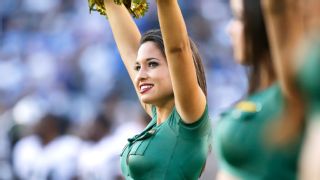 Stats Of The Week No. 3: Ryan Mallett threw his first touchdown pass in his four-year career. Stats Of The Week No. 4: Robert Griffin III is on a 1-8 run. Stats Of The Week No. 5: The Manning brothers combined to throw seven interceptions. Stats Of The Week No. 6: The Raiders are on a pace for 1,008 yards rushing. Lowest in a 16-game season was 1,062 yards by the Chargers in 2000. Stats Of The Week No. 7: The Dolphins have outscored their past two home opponents 59-9. Stats of the Week No. 8: Green Bay has outscored all home opponents by 219-85. Stats Of The Week No. 9: In two meetings in less than a year, the Colts allowed New England 478 yards rushing. Stats Of The Week No. 10: At 2-8, the Buccaneers are two games out of first in the NFC South. 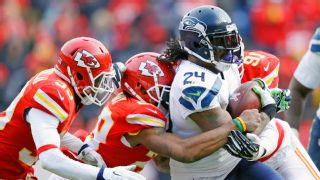 Sweet Plays Of The Week: Leading 24-20, Kansas City had the defending-champion Seahawks facing second-and-goal on the Chiefs' 4 with eight minutes remaining. A completed pass produced no gain; the Chiefs held Marshawn Lynch to 2 yards; on fourth-and-goal from the 2, incompletion. Now it's under four minutes, same score, and the Bluish Men Group faces fourth-and-1 in Kansas City territory. Lynch up the middle -- no misdirection, just a dive -- stuffed, Chiefs' ball. Short-yardage Kansas City defense in the fourth quarter was the week's sweetest plays. Sweet Plays Of The Week: Leading 24-20, Kansas City had the defending-champion Seahawks facing second-and-goal on the Chiefs' 4 with eight minutes remaining. A completed pass produced no gain; the Chiefs held Marshawn Lynch to 2 yards; on fourth-and-goal from the 2, incompletion. Now it's under four minutes, same score, and the Bluish Men Group faces fourth-and-1 in Kansas City territory. Lynch up the middle -- no misdirection, just a dive -- stuffed, Chiefs' ball. Short-yardage Kansas City defense in the fourth quarter was the week's sweetest plays.
Sour Tactics Of The Week: Trailing Cincinnati 20-3 at the end of the third quarter, New Orleans did not go hurry-up. Minnesota didn't go hurry-up trailing late in the fourth quarter, but Minnesota has a rookie quarterback. The Saints have Drew Brees. Why was New Orleans holding a leisurely committee meeting when trailing late? Sweet 'N' Sour Play: Since advising Packers' fans to R-E-L-A-X, Rodgers has thrown 23 touchdown passes and two interceptions. Packers leading the Eagles 17-3 in the second quarter, Green Bay had first down on the Nesharim 27. Jordy Nelson running a "go" up the right sideline, with no safety help, was the play that killed Chicago the previous week. Now Nelson runs a "go" up the right sideline, touchdown and the rout is on. Sweet for home fans who have the simple common sense to wear plastic cheese on their heads. For the Eagles, they'd just spent a week watching film of this play torching the Bears and then allowed exactly what the Bears had allowed -- and to boot, no safety in sight. Sour. Grade Inflation In High School Playoffs: Prep football playoffs have begun, and as TMQ annually notes, many states have such large postseason fields with so many overlapping titles that hundreds of high schools around the country are crowned "state champion." But this takes the cake. As noted by many readers, including Mike Wallace of San Antonio, in the crazed Texas playoff brackets -- here's just one of a dozen brackets -- this year an 0-10 team made the postseason. Frank Underwood Schemes Behind The Scenes For Hollywood Subsidies: With deep-blue Maryland poised to swear in a fiscal conservative Republican governor, will Larry Hogan do something about handouts to Hollywood? According to the Washington Post, in recent years, Maryland has bestowed $37.6 million in tax credits on "House of Cards" and $22.7 million on "Veep." That means average people must be taxed more -- Maryland raised personal income taxes twice in the period -- so the Hollywood elite can be even richer. A running theme of "House of Cards" is that sinister politicians rob the public. The show itself robs the public. How very current!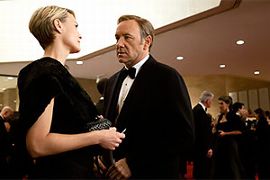 Reader Jerry Skurnik of New York City notes, "The Maryland film commission's claim that 'House of Cards' generated $250 million in benefits is as ludicrous as most plots of the series." A state legislature study cited in the above link supports the conclusion that the subsidies exceed any economic activity created. Benjamin Freed notes Maryland cut support of the fine arts in order to funnel subsidies to "House of Cards." Rather than fund local nonprofits producing music and theater -- a public-purpose case can be made for that -- Maryland subsidizes big-commercial efforts by Netflix, which ought to pay its own way. And it's not going out on a limb to suppose that Kevin Spacey or other Hollywood grandees involved in the show have said, "Why don't politicians do more to support the arts?" The NCAA Has No Shame: Last week, Louisville announced football coach Bobby Petrino is likely to receive a $500,000 bonus for the academic achievements of his players, "one of the largest academic bonuses in NCAA history." Doesn't that sound like exactly the kind of progressive coaching contract that should be encouraged? But look what constitutes academic achievement in this context: an NCAA-calculated Academic Progress Rate of at least 935. This translates into assurance that most Louisville football players are at a GPA of roughly a C-minus. That's better than athletes who don't go to class at all, but it doesn't seem like much to get excited about. 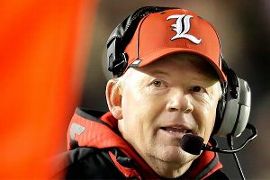 As this column has shown, a decade ago the NCAA created the APR to divert attention from graduation rates. (Full details are in my book "The King of Sports.") The graduation rate is a clear, easily understood metric. Nobody knows what the APR means -- which is exactly the way the NCAA likes it! Here's the definition: "Each student-athlete receiving athletically related financial aid earns one retention point for staying in school and one eligibility point for being academically eligible. A team's total points are divided by points possible and then multiplied by one thousand to equal the team's Academic Progress Rate score." So one point per each player who's living in a dorm and attending practice, one more point for each player who's "academically eligible." What does that latter mean? Football players must have a GPA of 1.8 to 2 depending on their class year and each school's own grade standards. That's a C-minus to a C. Division I football programs are allowed 85 athletic scholarships and are almost always at that number. Running the APR formula, we find that if all players are present at practice and have at least a 1.9 GPA (or whatever the school sets as a minimum standard), the APR is 1000. One thousand is a perfect score on the APR scale. To the NCAA, a C-minus is perfection! What gets a football program to 935? If all 85 players are living in dorms and coming to practice, and 74 have a GPA of at least C-minus, while 11 are flunking out, the result is an APR of 935. This sort of thing is why the NCAA likes the mysterious APR rather than the easily understood graduation rate. When Louisville players do not go on to the NFL, and hardly any of them will, they will enter the job market. Potential employers won't ask, "Did you attend an APR-compliant institution?" They will ask, "Did you graduate from college?" Louisville's standard football graduation rate is 62 percent. And the coach is in line for a half-million-dollar academic bonus. PC Watch: My children are graduates of the Montgomery County, Maryland, public school system, which annually proves that public schools can provide excellent education and do so in a cost-effective manner. Ovetta Wiggins of the Washington Post: "Montgomery County Public Schools regularly rates among the top-performing districts in Maryland and spends $12,649 per student, according to a new study of the 2011-12 school year, far less than the public school system in the District of Columbia, which spent $15,743 per student but ranks poorly nationwide." But no school system is immune from the PC tide washing over education. Last week, MCPS decided it would stop putting religious words such as Easter and Rosh Hashanah on school calendars. Breaks will still coincide with Christian and Jewish holidays, but for 2015-16, the school system will pretend this is unrelated to religion. The action was taken in part to allow the school systems to avoid dealing with whether schools should observe Eid al-Adha as a holiday. Whether public schools should observe Muslim holidays is a fair question. Not only ought Muslims to have a voice in holiday scheduling, but what about the many students and their families who live by ethical rules rather than religious ones -- don't their concerns matter too? In any event, pretending that Christian and Jewish holidays are not being observed, rather that breaks merely coincide with those events, makes educators look silly. There's no Establishment Clause reason public schools cannot acknowledge religious days; the Establishment Clause says only that government can neither ban nor mandate faith. Resorting to euphemism doesn't address any of the issues concerning how schools deal with faith, but does allow Fox News to claim a "war on Christmas." Last year, the war on Christmas ended in unconditional surrender by the attacking forces. 'Tis Better To Have Rushed And Lost Than Never To Have Rushed At All: Trailing 16-10 late in the fourth quarter, Jersey/A reached first-and-goal on the Santa Clara 4. The Giants went incompletion, incompletion, incompletion, interception. All three incompletions were attempted fades to the corners of the end zone. Jersey/A might as well have handed out cards reading, "Next play is fade to left corner." The High School With 11 Principals Points To What's Wrong With Education Spending: Whether higher spending improves public education is a topic of perennial debate: No matter how skilled teachers are and how hard they work, they can't control home environment and they can't stop peer pressure. And a factor in rising spending on education, coupled to mixed results, is the shift of resources from the classroom to administration. Consider T.C. Williams High School of Alexandria, Virginia, a well-regarded school that was put on the national map by the movie "Remember the Titans." Soon T.C. Williams, which long has played on Saturday afternoon, is poised to join the Friday-night-lights crowd. That's good news for the Titans. Spending at the top of the school might not be such good news. T.C. Williams is a large institution with two campuses, a satellite campus and about 3,300 students, so would be expected to have a large front office. But T.C. Williams has two principals, two executive associate principals, four assistant principals, a lead academic principal, two other academic principals and six deans. That's 17 high-level administrators, one per 194 students. Even if all 17 are working hard, this represents staff money diverted from teaching to memo-writing and meetings. Is this because Alexandria is a high-income area? Yours truly attended Kenmore West High School in Kenmore, New York -- we played Ron Jaworski's Lackawanna High -- about a mile from the Buffalo city line. When I was present, the school, then a grades 10 to 12 senior high, had 3,000 students, a principal and three assistant principals -- one high-level administrator per 750 students. Today, Kenmore West has about 1,350 students in grades 9 to 12, a principal and two assistant principals, or one high-level administrator per 450 students. Even in an area with a notably lower income than Alexandria, school resources are being diverted to administration. Administrative fiefdoms that actively harm education have been recent sources of controversy in the public school systems of Atlanta, Chicago, Newark, New York City and Prince George's County, Maryland, just outside Washington D.C. The trend toward money diverted to administrators is seen in many aspects of education. A 2010 study notes, "Between 1993 and 2007, the number of full-time administrators per student at America's leading universities grew by 39 percent, while the number of employees engaged in teaching, research, or service only grew by 18 percent. Inflation-adjusted spending on administration per student grew by 61 percent during the same period, while instructional spending per student rose 39 percent." Heather Mac Donald of New York's City Journal cites this example: During the same period the vice president of the California University school system claimed costs were being "cut to the bone," the University of California at San Diego added senior administrative positions such as associate vice chancellor for faculty equity. In public schools, some of the increasing administrative cost is the result of laws and rules regarding improved treatment for students with disabilities. At the college level, increasing administrative deadweight might be in part a response the culture of grievance that is among academia's faults -- at many campuses, students and faculty alike avidly search for things to complain about. But some deadweight simply looks like overstaffing. The Office of the Vice Provost at Tufts University has 67 positions, including two associate directors for licensing and two licensing associates. Can the Tufts elephant logo -- or Tufts research -- be drawing such incredible licensing business that four administrators are needed? This study shows that at many large public universities in recent years, administrative spending has been rising and college-president pay as been rising a lot, while spending on permanent faculty has been declining. "Student debt and low-wage faculty labor are rising faster at state universities with the highest-paid presidents," the study found. Meanwhile, the Chronicle of Higher Education reports that nine public universities now lavish on their presidents at least $1 million per year -- largess that originates with taxpayers and with students going into debt. At many colleges, administrators seeking to cut teaching costs, and thus free more money for front-office deadweight, are moving toward MOOCs ( massive open online courses) replacing classroom time. Laurie Essig, writing for the indispensable Chronicle of Higher Education, proposes MOOAs -- put the administrative functions online. Authentic Games Standings: The Authentic Games standings are refreshed as the NFC South is exiled and prior games versus New Orleans removed from consideration. Kansas City rockets to the second position, while San Diego -- pasted at Miami, then taken to the final snap by the woeful Raiders -- verges on Authentic elimination. Can the Rams really be an Authentic team even with an overall losing record? They've defeated both of last season's Super Bowl entrants, Seattle and Denver, which sounds pretty Authentic, so they're in for the moment. Indianapolis and defending champion Seattle both are fading fast, as the Go Gos would say. Down the stretch, the defending champions play five of six versus Arizona, Philadelphia and Santa Clara. Even if the Niners are themselves on the verge of fade-out, there is no love lost between them and the Seahawks, so the home-and-home contests should be hotly contested. In the preseason, your columnist said Seattle not only was a long shot to repeat, but that the Hawks were a long shot to reach the playoffs. One reason I was skeptical about Seattle's chances was free-agency losses on the defensive line, and now defensive tackle Brandon Mebane is out for the season, too. Santa Clara is struggling -- 32 sacks allowed, ye gods -- but remains in the Authentic Games Index out of respect for three straight NFC title game appearances. Even the Football Gods Said Ye Gods: Tennessee came into its "Monday Night Football" game against the Steelers with a 2-7 record. Its season has become a flaming thumbtack, the sole remaining highly anticipated moment being to host MNF. With seven minutes remaining, trailing 27-24, the Flaming Thumbtacks faced fourth-and-4 in Pittsburgh territory. Ken Whisenhunt sent in the punt unit. You don't need to know anything else to know who won the game. But in case you are interested, on the night, Tennessee averaged 8 yards per offensive down, and after the punt, never touched the ball again. TMQ pounds the table about coaches ordering punts on short-yardage situations in opposition territory not because this makes sense, but for blaming-shifting. If the coach orders a fourth-down try that fails, he gets the blame; if he does the "safe" thing with a punt and then loses, the players get the blame. But there's a second level to the absurdity of too much punting. As this and today's Buffalo Bills items show, teams that punt on fourth-and-short on the opponent's side of the field pretty consistently are losing teams. No matter how concerned the coach may be with avoiding criticism -- reader Jon Turner of Shallowater, Texas, notes Texas Tech coach Kliff Kingsbury said in the offseason that if he was secure against being fired he'd never punt -- what ought to jump out is that buck-buck-brawkkkkkk style punts are a losing tactic.  Unified Field Theory Of Creep: Your columnist likes Starbucks' Thanksgiving blend and always picks up a couple of pounds in whole bean around this time of year. Apparently, I waited way too long. Reader Joe Hodanich of Bethesda, Maryland, reported on Nov. 12: "I couldn't get Thanksgiving blend today at my Starbucks, which has already switched to Christmas blend -- 15 days before Thanksgiving."  The same mid-November day that Joe was frustrated in his quest for Thanksgiving blend, the Official Wife of TMQ, a globe-trotting U.S. diplomat, checked into a Switzerland hotel whose lobby was festively adorned for Christmas. At least Europe has a Christmas Creep excuse -- some families give their children their presents on Dec. 6, Saint Nicholas Day. When the Official Wife and I lived in Belgium, we had our children put their shoes by the door before bed on Dec. 5 -- Sinterklaas filled the shoes with chocolates overnight. I'd like it if Sinterklaas brought me some Starbucks Thanksgiving blend. The nearby picture is of last week's lobby display in the Hotel President Wilson, a reminder of the period when Woodrow Wilson was more popular in Europe than in the United States. The same mid-November day that Joe was frustrated in his quest for Thanksgiving blend, the Official Wife of TMQ, a globe-trotting U.S. diplomat, checked into a Switzerland hotel whose lobby was festively adorned for Christmas. At least Europe has a Christmas Creep excuse -- some families give their children their presents on Dec. 6, Saint Nicholas Day. When the Official Wife and I lived in Belgium, we had our children put their shoes by the door before bed on Dec. 5 -- Sinterklaas filled the shoes with chocolates overnight. I'd like it if Sinterklaas brought me some Starbucks Thanksgiving blend. The nearby picture is of last week's lobby display in the Hotel President Wilson, a reminder of the period when Woodrow Wilson was more popular in Europe than in the United States.
Song I'm Blaring: That thing where you can't stop playing the same song: I can't stop playing this new song. Cognomen Update: Since they departed San Francisco, TMQ has taken to calling Jerry Rice's old team the Santa Clara 49ers. I've long referred to the Giants as Jersey/A and the Jets as Jersey/B. I call the Bucs the City of Tampa Buccaneers because Tampa Bay is a body of water: Tampa, Florida, is where the team performs. I don't just object to the Rdskns part of the team owned by Chainsaw Dan Snyder; I object to the Washington part, as the Rdskns practice in Virginia and perform in Maryland. Thus, to this column they are the Potomac Drainage Basin Indigenous Persons. Many readers, including Anand Iyer of San Francisco, have been protesting my use of "Santa Clara 49ers," including by asking why I don't refer to the Arlington Cowboys and the Orchard Park Bills. Jerry Jones' flying saucer is about 19 miles from Dallas and within an area that has long presented itself to the nation as DFW. Ralph Wilson Stadium is about 11 miles from Buffalo and is part of the same county. Levi's Stadium is at least 42 miles from San Francisco and is in a different county; Santa Clara and San Francisco differ sociologically in countless ways. That's why the Santa Clara 49ers but not the Arlington Cowboys or Orchard Park Bills. In lore, romance and historical significance, San Francisco is among the top cities in the world. The many lovers of San Francisco seemed pretty steamed the phrase "San Francisco 49ers" is rapidly slipping into the dustbin -- even television announcers are referring to the team as Santa Clara. That's because the San Francisco 49ers left San Francisco and don't exist anymore. 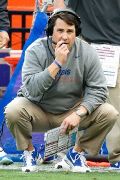 ESPN Grade Evaluates The Muschamp Dismissal: Coach Will Muschamp was shown the door at Florida for the unimaginable sin of going only 27-20 so far in four seasons. Just two years ago, when the Gators were ranked second, Muschamp was being proclaimed a great coach -- in the past two years, he must have forgotten everything he knew! Florida's latest football graduation rate is an admirable 81 percent, which puts the Florida program in excellent company -- near academic leaders Notre Dame, Duke, UCLA and TCU. Analyzing the Muschamp dismissal, did any sports touts even mention the strong graduation rate -- that is, regard "student-athletes" as actual student-athletes? Maybe Muschamp's error was working to make sure his players were in class rather than spending every second in the weight room or film room. Climate Change Action Is Required Because Editors Are Running Out of Hot-Air Headlines: Last week the United States and China made a nonbinding pledge to reduce greenhouse gases. Climate change is real -- don't believe the United Nations. Believe the American Association for the Advancement of Science. Polls show most voters believe climate change is real, so let's hope the United States-China handshake means progress.  Barack Obama was extensively praised by the establishment media for last week's announcement, and perhaps that praise was deserved. Yet 22 years ago when the elder George Bush went to the Rio Earth Summit and made a pledge to reduce greenhouse gases, the establishment media lambasted him for refusing to commit to a binding mechanism for mandatory reductions. What Obama agreed to last week isn't meaningfully different from what the elder Bush agreed to in 1992, though it's nice to now have China on board -- nonbinding, of course. The carbon intensity -- carbon dioxide per dollar of output -- of the U.S. economy has been declining for at least half a century. See the graph on page six. Trends in technology, mainly energy efficiency, are the main driver in the decline. The United States greenhouse gas reduction target Obama promised last week (another too-wordy greenhouse goal, of reducing U.S. emissions by 26 to 28 percent, compared to 2005, by 2025) is something that's likely to happen anyway, owing to improving energy efficiency, plus rising use of natural gas and electricity from renewable sources. See the graph on page ES-5). So all Obama really promised in China was that existing trends will continue. Since existing trends are positive, let's hope they do continue. Market forces might be enough to reduce greenhouse gas emissions in the short term. To the extent regulation might be needed, it would be far better if Congress enacted legislation than if the White House and EPA promulgated regulations whose effect will be to let federal judges decide. Under the elder President Bush, the Republican Party scored a dramatic success with the acid rain permit trading program that has since reduced acid rain (76 percent reduction in sulfur dioxide, the primary agent of acid rain, since 1990) at far less cost than expected. Bush's acid rain trading program was everything government should be -- effective, affordable, flexible, run from the bottom up rather than the top down. The Republican Party has every reason to be proud of this program. A decade ago, prominent Republicans, including John McCain, wanted to create a carbon-trading program modeled on this success. Carbon trading is a great idea and likely to be effective and affordable. Now controlling Congress, Republicans could seize the day and be the ones to enact carbon trading. Or we could wait to see what federal judges impose. Brace yourself for environmentalists saying that falling gasoline prices is a disaster. The more fossil fuels cost, the greater the incentive to switch to renewables -- but the reverse is true, too. Not only are fossil fuel prices declining, so are prices of many commodity metals. Market economists would call this good news: Technology and innovation drive down costs, and everyone comes out ahead, but establishment liberal opinion tends to think that unless action originates with government, it must be sinister. Lower prices for commodities may be spun as the next thing to worry about. Patriots Spokesman Denies Rumor That Belichick Sold Soul To Devil: TMQ's prediction of Indianapolis to the Super Bowl is fading fast. Meanwhile, has any NFL team ever rebounded as spectacularly as the Patriots? Blown off the field by Kansas City at the end of September, now the Flying Elvii have back-to-back wins over Denver and Indianapolis by a combined 85-41. 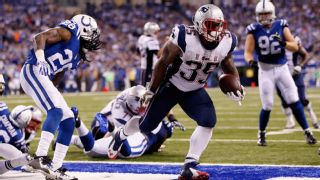 Once again, Bill Belichick is doing it with guys you've never heard of. Sunday night at Indianapolis, the Patriots started four undrafted players, including oft-waived total unknown Jonas Gray, who didn't start much in college. Starters included several players most other teams didn't want -- Brandon Browner, Michael Hoomanawanui, Chris Jones. Putting an airborne Elvis decal on your head seems to make you a better athlete. TMQ lauds New England for varying its game plans more than any other NFL team, and Sunday night was no exception. The Colts expected the Patriots offense to show the five-receiver sets it's been featuring this season. Instead, New England used two tight ends and a fullback. Obsessed with getting sacks, the Indianapolis defensive front loves line stunts and twists: These create pressure on the quarterback but require defenders to make an initial sideways move. So Belichick had the Patriots use trap pulls and tight-end wham blocks -- slamming Indianapolis front-seven players in their sides while their own momentum was already sideways. The result was 244 yards rushing for New England, and these second-half possession outcomes: touchdown, touchdown, touchdown, touchdown, kneels to end game. As for Indianapolis, one doesn't win many games in which one is outrushed by 225 yards at home. The Colts' tailbacks combined for 14 carries for 4 yards -- those are white-flag numbers. Indianapolis entered on an 0-4 streak versus New England, had an NFL extra week to prepare and a raucous home crowd. It was must-win for the Colts -- and they got outscored 28-10 in the second half.  Wacky Whisky of the Week: Advertising copy writers like exclamation-point statements that don't have any factual meaning -- "Now with more taste!" Cragganmore scotch claims the "most complex aroma" of any single malt. Wacky Whisky of the Week: Advertising copy writers like exclamation-point statements that don't have any factual meaning -- "Now with more taste!" Cragganmore scotch claims the "most complex aroma" of any single malt.
Adventures In Officiating In swirling snow at Chicago, Jay Cutler was hit before his arm started forward, losing the ball in an "empty hand" gesture. Three Vikings scrambled for the ball, one falling on it after several bounces. Officials incorrectly ruled incompletion. After a Minnesota challenge, officials ruled fumble but that possession could not be awarded to the Vikings because replay can only award possession if a fumble is recovered "immediately." Huh? Set aside that it was only a couple seconds from when the ball hit to the turf to when a Minnesota player recovered, which sounds fairly immediate. The rulebook says possession may be awarded if "the recovery of a fumble by an opponent or teammate occurs in the action that happens following the fumble." Perhaps there's some reference to immediate recovery in the officiating guidelines the NFL won't disclose. If there's any reference to this concept in the rulebook, I couldn't find it. In the third quarter at St. Louis, Denver's Emmanuel Sanders, sprinting deep, was hit helmet to helmet by Rodney McLeod while in a defenseless posture. Personal foul was flagged, and the St. Louis crowd booed. The call was correct -- and consider that five years ago, the play would have been legal. It's a sign of change in football culture. Upholding the A.J. Green fourth-quarter touchdown catch that put Cincinnati ahead 27-10 at New Orleans, referee Craig Wrolstad announced, "The receiver's left toe was inbounds." Replay can see a player's toes? Arizona leading Detroit 14-6 early in the fourth quarter, the Cardinals tried to pin the visitors deep with a punt. A coverage man stopped the punt at the Detroit 1, held the ball for an instant, then pushed it back up the field; a Detroit player snagged the ball and ran to the Arizona 46. Bruce Arians challenged, and officials brought the spot back to the Detroit 1, saying that because the coverage man had "possessed" the ball, it should have been whistled dead. Had the action of the down been the same except the coverage man was a wide receiver trying to make a reception, zebras surely would have ruled incompletion. Then, Arizona facing third-and-11 just before the two-minute warning, officials gave the home team a very favorable spot on a Larry Fitzgerald reception, barely enough for the icing first down. There will be grumbling about that call in Michigan taverns all week.  Happy Hour In Hell's Sports Bar Hell's Sports Bar has an infinite number of flat-screen HDTVs, but certain blackout restrictions may apply. Sunday, the fantastic late-slot pairings -- 7-2 Detroit at 8-1 Arizona, 7-2 Philadelphia at 6-3 Green Bay -- did not air in Hell's Sports Bar, where patrons could tune in to only 0-9 Oakland, league's sole winless team, versus San Diego. Happy Hour In Hell's Sports Bar Hell's Sports Bar has an infinite number of flat-screen HDTVs, but certain blackout restrictions may apply. Sunday, the fantastic late-slot pairings -- 7-2 Detroit at 8-1 Arizona, 7-2 Philadelphia at 6-3 Green Bay -- did not air in Hell's Sports Bar, where patrons could tune in to only 0-9 Oakland, league's sole winless team, versus San Diego.
If you want to know what is airing where, use a fabulous independent website, The506.com, run by J.P. Kirby, a Canadian. (Five-oh-six is the area code for New Brunswick.) The 506.com has everything except the playlist for dance night at Hell's Sports Bar. Note that for the late-slot start, Fox had the call for both Philadelphia at Green Bay and Detroit at Arizona and chose to show most of the nation the former contest, though the latter offered the best combined records (15-3) so far this season. One reason the Cardinals' power defense is little known to the football audience is that viewers east of the Mississippi rarely see Arizona games. Why Certain Teams Are On A 2-19 Road Streak: Trailing San Diego 13-3 with four minutes remaining, Oakland faced fourth-and-2 on the Bolts 7 -- and took the field goal. Yes, the Raiders needed 10 points, but a field goal can be launched from long distance, while touchdowns require crossing the goal line. Needless to say, Oakland would not get close to the goal line again. Tactics note: trailing by seven and out of timeouts, Oakland had second down on its 41 with 11 seconds remaining. Most teams in this situation throw a quick out to gain 10 or 15 yards, have the receiver step out of bounds and then launch a slightly less improbable Hail Mary as time expires. San Diego lined up with a linebacker standing along each sideline about 10 yards downfield so Oakland could not employ the quick-out tactic. That forced the Raiders to throw their Hail Mary right away -- incompletion and game over. Why Certain Teams Are On A 6-20 Overall Streak: Trailing 1-8 City of Tampa at home, the Potomac Drainage Basin Indigenous Persons reached first-and-goal. What happened next: penalty, gain of 1 yard, sack, sack, missed field goal.  Famous College Obscure Score: It was MIT 24, Coast Guard 13 as the Engineers tuned up for their first-ever appearance in the Division III playoffs. The stands were even packed, and when's the last time that happened for MIT football? Famous College Obscure Score: It was MIT 24, Coast Guard 13 as the Engineers tuned up for their first-ever appearance in the Division III playoffs. The stands were even packed, and when's the last time that happened for MIT football?
TMQ had an item about MIT football three years ago and noted the MIT football team has cheerleaders. Here is a proposed MIT cheer: "Our hands are high our feet are low/and into the clouds our IQs go." Manly Man Play Of The Week (Mid-major Edition): Last week TMQ chided the oddly named University at Buffalo for punting on fourth-and-short in opposition territory while trialing; needless to say, UATB went on to lose. This time, Buffalo trails the wonderfully named Akron Zips, whose logo is a high-tech kangaroo -- oh, for a football game between the Zips and the Ichabods of Washburn University -- in the first quarter and faces fourth-and-3 on the Zips' 33. Buffalo lined up in a Four Horsepersons backfield. A back went in motion far to the right to provide misdirection; the quarterback took a shotgun snap and ran straight ahead, as if to try to rush for the first down; then, he jumped straight up and lobbed a shot pass to the tight end, who had stepped a few yards downfield uncovered. Thirty-three-yard touchdown to tight end Matt Weiser, and UATB goes on to win by 31 points. This action is the "pop pass," a standby of high school offenses, a favorite of Tim Tebow when he was at Florida and a play that is fun to watch. Mississippi State -- coached by Dan Mullen, who was Tebow's position coach at Florida -- tried the pop pass Saturday at Alabama, though the ball clanged incomplete. I've never seen it called in the NFL, perhaps because professional coaches don't want people to say, "You're so desperate you're using high school trick plays." 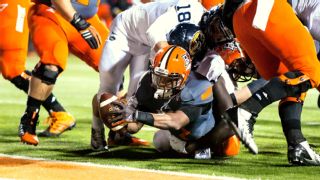 Over to You, Paul Lukas: Book covers look classier all the time, and so do college football uniforms. Why is there more creativity in college football livery than in the pros? The reasons. Just remember you can't judge a book by its cover. Why Tactics Matter: In NCAA action, leading by two points at Arizona, mega-underdog Washington had first-and-10 near midfield, 1:33 showing, the hosts down to their final timeout. Had Washington knelt three times, the worst case was punting back to Arizona with about 20 seconds remaining. True, such a punt might have been blocked, but the likely result would have been forcing Arizona to go about 50 yards in 20 seconds with no timeouts. Instead, Washington ran a play, and that's all you need to know. Notre Dame faced a nearly identical situation. Leading Northwestern by three points with 1:35 remaining and the Wildcats out of timeouts, the Irish faced second-and-8 on the Northwestern 31. Notre Dame could have knelt twice, then punted into the end zone with about 20 seconds showing. Instead, Notre Dame ran a play, and that's all you need to know. True, a coach can't be afraid to have his team run plays, but in the last-minute, clock-killer situation, when the defense is close to certain the call will be a rush between the tackles, risk of a fumble rises as defenders all swipe at the ball. Buck-Buck-Brawkkkkkk: Trailing by 10 points in the fourth quarter at Miami, the Bills faced fourth-and-6 in Dolphins territory -- and sent in the punt unit. Words fail me. One reason for Buffalo's league-worst, 15-year playoff drought -- the Bills haven't been to the postseason in this century -- is timorous coaches who play not to lose rather than play to win. The last three especially -- Dick Jauron, Chan Gailey and now Doug Marrone -- were wedded to conservative tactics, launching punt after punt in opposition territory and never seeming to realize this had anything to do with their combined 51-80 record. In a span of five days -- at home versus Kansas City, then the Miami road game -- the Bills lost two games while scoring just one touchdown. Not only did Marrone order punts in opposition territory versus both the Chiefs and Dolphins; not only did Marrone punt on fourth-and-1 near midfield when trailing Kansas City in the fourth quarter. Four times in five days the Bills had fourth-and-goal or fourth-and-short in the red zone, and all four times Marrone sent in the kicking unit. The Bills face yet another housecleaning in the offseason, but this time the entire front office should go, too. It's the front office that hires the timid coaches and makes the nutty draft-day decisions. With Buffalo and Miami each 5-4 at kickoff, the game was essentially an elimination contest, since at least 10 wins will be required for an AFC wild card this season. Buffalo is now all but mathematically done, while at 6-4, Miami joins the postseason conversation coming off three consecutive strong performances -- emphatic home wins versus the Chargers and Bills and a close road loss at Detroit. Down the stretch, Miami has winnable dates against Minnesota and Jersey/B twice. The Dolphins' issue is their other final opponents are Baltimore, Denver and New England. Playing at Denver this coming Sunday, Miami has an opportunity to knock on the door of the league's elite. Buck-Buck-Brawkkkkkk No.2: Trailing 24-3 at Green Bay, the Eagles punted on fourth-and-6 in Packers territory. It took Green Bay four snaps to pass the point where the ball would have been had Philadelphia gone for it and missed. Philadelphia went on to lose by 33 points.  Buck-Buck-Brawkkkkkk No.3: Trailing 14-6 at the end of the third quarter at Arizona, Detroit punted on fourth-and-1 from midfield. You don't need to know anything else. Buck-Buck-Brawkkkkkk (Football Factory Edition): Game tied with 1:38 remaining in regulation, Stanford punted on fourth-and-7 from the Utah 34. That's all the information you need to know who won. The 500 Club Reader Phil Molter of Daegu, South Korea, reports: Matthew C. Perry High School of Marine Corps Air Station on Iwakuni, Japan, gained more than 580 yards, scored 50 points and lost to Daegu High School from U.S. Army Garrison Daegu, South Korea, in the Far East Division II championship of the U.S. Department of Defense Education Activity Schools -- Pacific. Visiting Cincinnati, East Carolina gained 572 yards and lost. Visiting Arizona, Washington gained 504 yards and lost. The 600 Club: Hosting Prairie View, Alabama A&M gained 627 yards, was plus-1 in turnover margin, controlled the clock with 38:18 time of possession and lost. In Texas prep playoff action, Wylie East scored 63 points and lost by two touchdowns. The 700 Club: in California prep playoff action, St. Bonaventure scored 70 points and lost. Clubs All Their Own: Tevin Coleman of Indiana rushed for 307 yards at Rutgers, which turned out to be nowhere near enough because Indiana lost by 22 points. In North Carolina prep action, B.J. Emmons of Freedom High rushed for 431 yards in a loss. Those zany Racers of Murray State have posted winning scores of 86-29 and 73-26 and are 3-8. Obscure College Score: Augsburg 62, Bethel 61. The Bethel Royals joined The 500 Club by gaining 589 yards and losing; they also joined The 600 Club by scoring at least 60 points and losing. In heavy snow, Bethel went for two and the win in a second overtime and was denied. Despite the heavy snow, the schools combined for 882 yards passing. Located in St. Paul, Minnesota, Bethel University sponsors an Anime Club that seeks to "increase understanding of Japanese animation and culture through the critical viewing and discussion of artistically valid and Bethel-appropriate works." Single Worst Play Of The Season -- So Far (Update): Last week the Bears won this accolade for failing to have anyone at all cover Jordy Nelson as he streaked deep for a 73-yard touchdown. TMQ blamed a bad defensive call by Bears defensive coordinator Mel Tucker. Now the Chicago Tribune reports that Lance Briggs made the bad call: "I saw something, tried to check out of it and we don't have a check out of that defense." TMQ has been maintaining for a while that a reason for increased scoring is that NCAA and NFL defenses now make so many last-second, pre-snap checks and shifts, they end up only confusing themselves. This is a prime example. Next Week: Should punting on fourth-and-short in opposition territory be a penalty?
|

